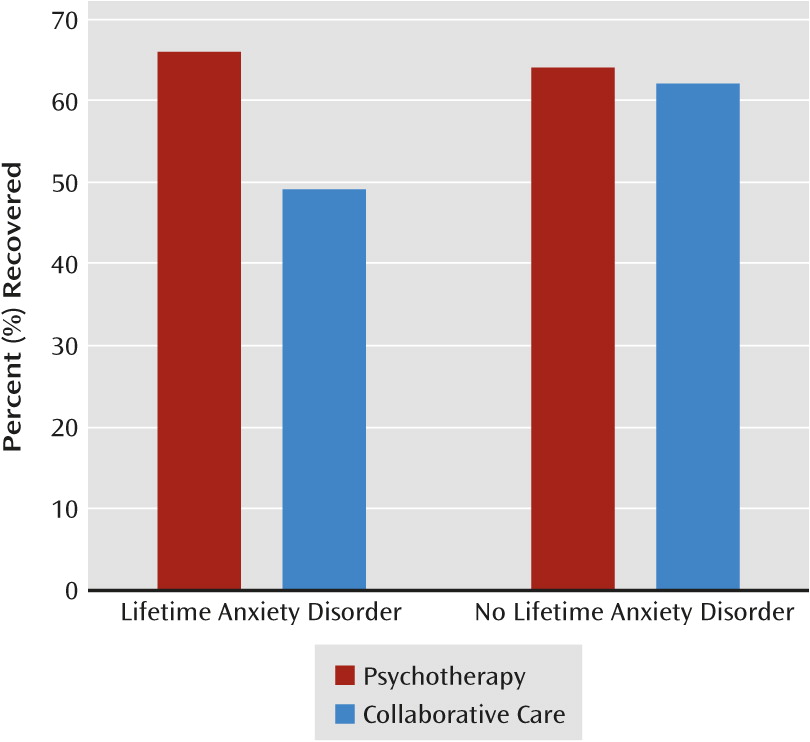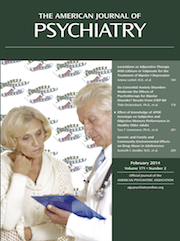Do Comorbid Anxiety Disorders Moderate the Effects of Psychotherapy for Bipolar Disorder? Results From STEP-BD
Abstract
Objective
Method
Results
Conclusions
Method
Study Design
Participants
Assessment of Primary Outcomes
Statistical Analyses
Results
Study Sample
| Characteristic | Lifetime Anxiety Disorder (N=177) | No Lifetime Anxiety Disorder (N=92) | Overall (N=269) | Lifetime Anxiety Disorder Compared With No Lifetime Anxiety Disorder | |||||
|---|---|---|---|---|---|---|---|---|---|
| Mean | SD | Mean | SD | Mean | SD | df | t | p | |
| Age (years) | 40.47 | 9.97 | 39.73 | 12.28 | 40.22 | 11.64 | 264 | –0.49 | 0.63 |
| Age at illness onset (years) | 21.44 | 9.97 | 23.83 | 10.10 | 22.24 | 10.06 | 264 | –0.61 | 0.54 |
| Depressive severitya | 7.16 | 2.28 | 7.34 | 2.33 | 7.22 | 2.29 | 267 | 0.63 | 0.53 |
| Mania severityb | 1.18 | 1.06 | 1.06 | 1.12 | 1.14 | 1.08 | 267 | –0.85 | 0.4 |
| Number of sessions | 9.75 | 10.66 | 8.23 | 9.71 | 9.23 | 10.35 | 267 | –1.13 | 0.26 |
| Baseline Global Assessment of Functioning scale score | 55.61 | 9.21 | 57.89 | 9.46 | 56.40 | 9.34 | 264 | 1.9 | 0.06 |
| Comorbid conditions | 3.69 | 2.30 | 1.20 | 1.40 | 2.84 | 2.39 | 266 | –9.52 | <0.01 |
| N | % | N | % | N | % | N | χ2 | p | |
| Female | 114 | 65 | 46 | 50 | 160 | 59 | 267 | 5.76 | 0.02 |
| Education (>1 year of college) | 135 | 76 | 76 | 83 | 211 | 78 | 262 | 2.03 | 0.13 |
| Married | 66 | 37 | 20 | 22 | 86 | 32 | 269 | 6.73 | 0.01 |
| Diagnosis | 269 | 1.02 | 0.31 | ||||||
| Bipolar I disorder | 115 | 65 | 54 | 59 | 169 | 63 | — | — | — |
| Bipolar II disorder | 62 | 35 | 38 | 41 | 100 | 37 | — | — | — |
| >10 Manic episodes | 106 | 60 | 38 | 41 | 144 | 54 | 269 | 8.34 | 0.01 |
| >10 Depressive episodes | 105 | 60 | 45 | 50 | 150 | 57 | 264 | 2.56 | 0.11 |
| Baseline medications | |||||||||
| Mood stabilizers | 58 | 33 | 19 | 21 | 77 | 29 | 269 | 4.35 | 0.04 |
| Antidepressants | 93 | 53 | 26 | 28 | 119 | 44 | 269 | 14.47 | <0.01 |
| Atypical antipsychotics | 54 | 31 | 22 | 24 | 76 | 28 | 269 | 1.23 | 0.25 |
| Anxiolytics | 52 | 29 | 14 | 15 | 66 | 25 | 269 | 6.56 | 0.01 |
| Anticonvulsants | 106 | 60 | 40 | 44 | 146 | 54 | 269 | 6.57 | 0.01 |
| Lithium | 50 | 28 | 39 | 42 | 89 | 53 | 268 | 5.33 | 0.02 |
Anxiety Disorder Pathology
Do Lifetime Anxiety Disorders Moderate Responses to Psychotherapy Compared With Collaborative Care?
| Lifetime Anxiety Disorder | N | Number Recovered | Recovered (%) | Number Needed to Treat | SEa | 95% CI |
|---|---|---|---|---|---|---|
| Yes | ||||||
| Collaborative care | 78 | 38 | 49 | 5.88 | 7.40 | 3 to 13 |
| Psychotherapy | 99 | 65 | 66 | |||
| No | ||||||
| Collaborative Care | 42 | 26 | 62 | 50.00 | 10.10 | –6 to 5 |
| Psychotherapy | 50 | 32 | 64 |

Effects of Specific Anxiety Disorders
| Anxiety Disorder | Psychotherapy | Collaborative Care | Number Needed to Treat | SEa | 95% CI | ||||
|---|---|---|---|---|---|---|---|---|---|
| N | Number Recovered | Recovered (%) | N | Number Recovered | Recovered (%) | ||||
| Panic Disorder | |||||||||
| Lifetime | 59 | 34 | 57 | 38 | 17 | 44 | 7.69 | 10.30 | –14 to 3 |
| Current | 32 | 20 | 63 | 19 | 10 | 53 | 10.00 | 14.29 | –6 to 3 |
| Social Phobia | |||||||||
| Lifetime | 41 | 29 | 71 | 33 | 19 | 58 | 7.69 | 11.20 | –12 to 3 |
| Current | 31 | 21 | 68 | 25 | 14 | 56 | 8.33 | 13.00 | –8 to 3 |
| Obsessive-compulsive disorder | |||||||||
| Lifetime | 21 | 15 | 71 | 18 | 11 | 61 | 10.00 | 15.10 | –6 to 3 |
| Current | 10 | 7 | 70 | 13 | 7 | 54 | 6.25 | 20.00 | –5 to 2 |
| Posttraumatic stress disorder | |||||||||
| Lifetime | 45 | 28 | 63 | 18 | 8 | 44 | 5.56 | 13.80 | –12 to 2 |
| Current | 14 | 9 | 64 | 10 | 4 | 40 | 4.17 | 20.10 | –7 to 2 |
| Generalized anxiety disorder | |||||||||
| Lifetime | 42 | 25 | 60 | 26 | 7 | 27 | 3.03 | 11.50 | 2 to 12 |
| Current | 30 | 18 | 60 | 21 | 4 | 19 | 2.44 | 12.40 | 2 to 7 |
Current Specific Anxiety Disorders
Number of Anxiety Disorders
| Anxiety Disorder | Psychotherapy | Collaborative Care | Number Needed to Treat | SEa | 95% CI | ||||
|---|---|---|---|---|---|---|---|---|---|
| N | Number Recovered | Recovered (%) | N | Number Recovered | Recovered (%) | ||||
| Lifetime | |||||||||
| One anxiety disorder | 38 | 32 | 84 | 40 | 21 | 53 | 3.22 | 9.90 | 2 to 9 |
| Two or more anxiety disorders | 61 | 33 | 54 | 37 | 17 | 46 | 12.5 | 10.40 | –8 to 4 |
| Current | |||||||||
| One anxiety disorder | 11 | 9 | 71 | 23 | 14 | 58 | 4.76 | 15.50 | –8 to 2 |
| Two or more anxiety disorders | 53 | 30 | 68 | 32 | 14 | 56 | 7.69 | 11.10 | –12 to 3 |
Discussion
References
Information & Authors
Information
Published In
History
Authors
Funding Information
Metrics & Citations
Metrics
Citations
Export Citations
If you have the appropriate software installed, you can download article citation data to the citation manager of your choice. Simply select your manager software from the list below and click Download.
For more information or tips please see 'Downloading to a citation manager' in the Help menu.
View Options
View options
PDF/EPUB
View PDF/EPUBLogin options
Already a subscriber? Access your subscription through your login credentials or your institution for full access to this article.
Personal login Institutional Login Open Athens loginNot a subscriber?
PsychiatryOnline subscription options offer access to the DSM-5-TR® library, books, journals, CME, and patient resources. This all-in-one virtual library provides psychiatrists and mental health professionals with key resources for diagnosis, treatment, research, and professional development.
Need more help? PsychiatryOnline Customer Service may be reached by emailing [email protected] or by calling 800-368-5777 (in the U.S.) or 703-907-7322 (outside the U.S.).

